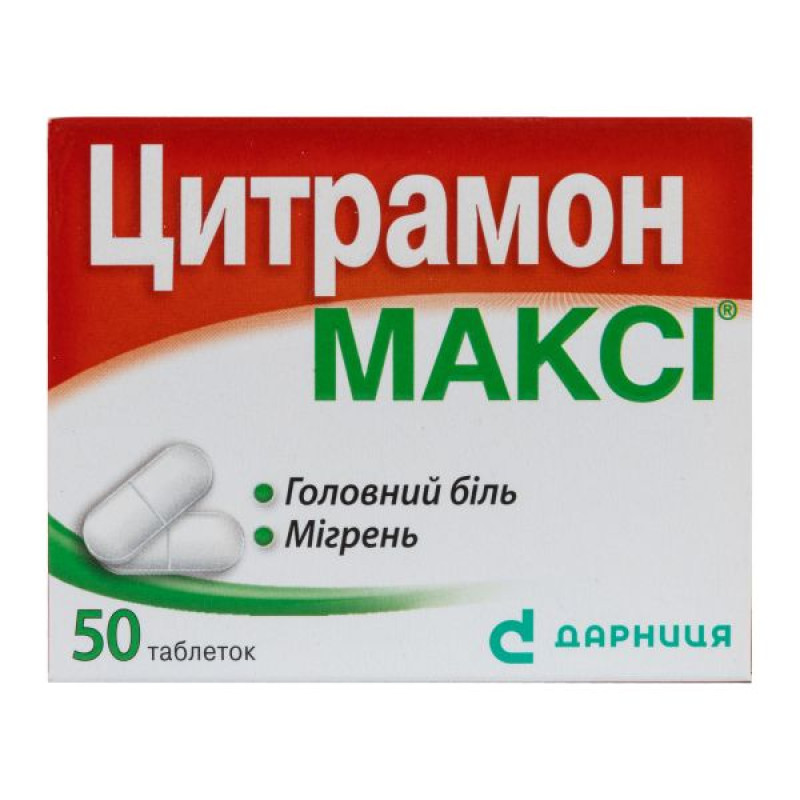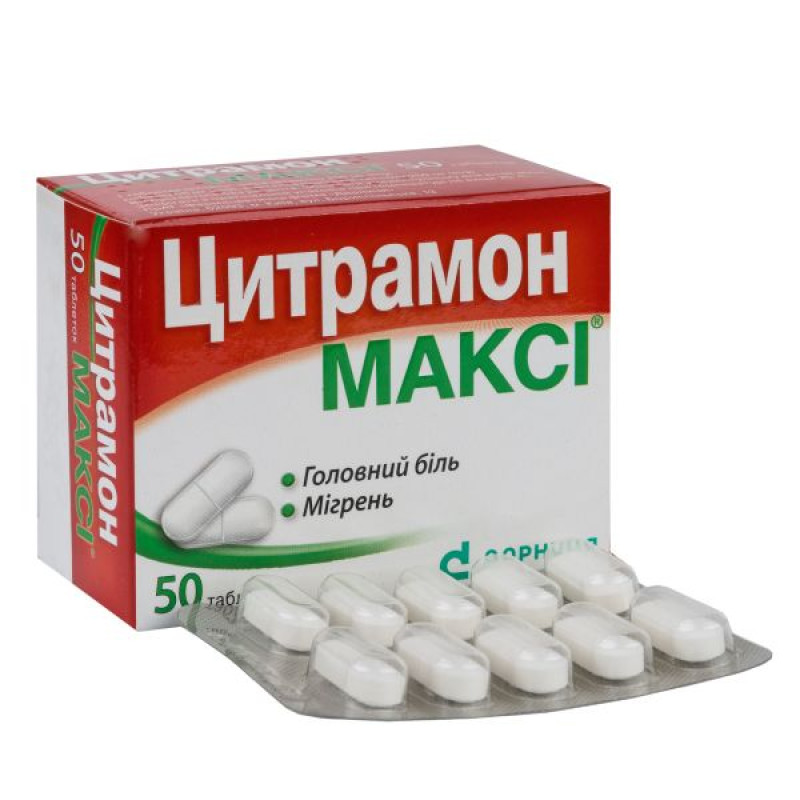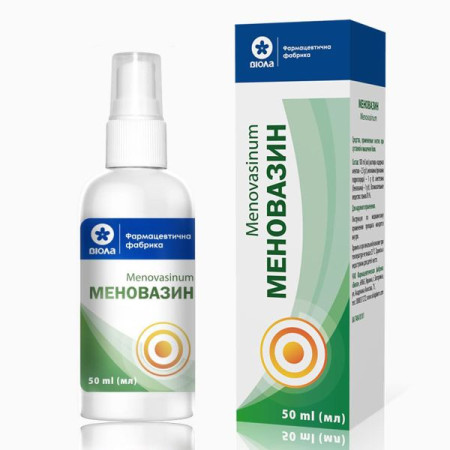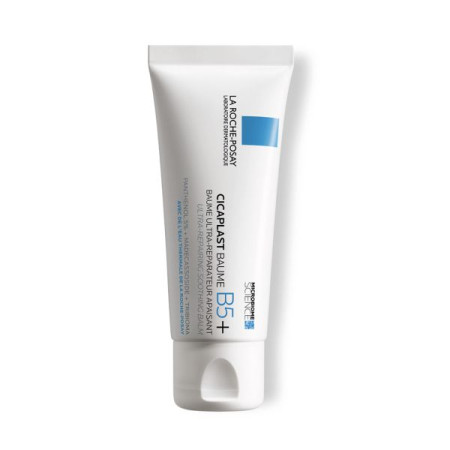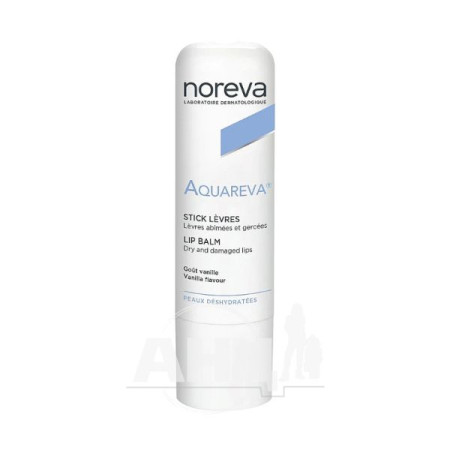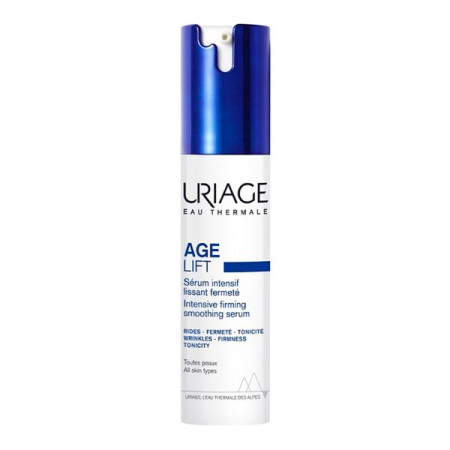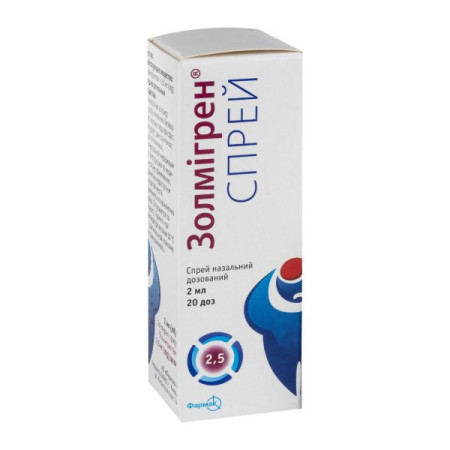Citramon maxi tablets No. 50
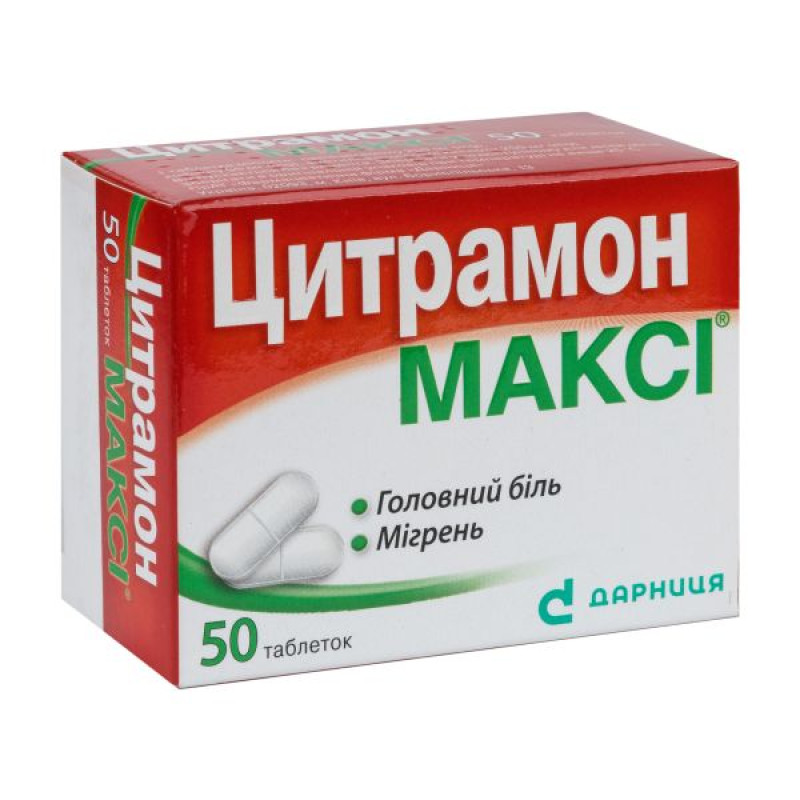
Instructions for Citramon Maxi tablets No. 50
Composition
active ingredients: paracetamol, caffeine, acetylsalicylic acid;
1 tablet contains: paracetamol 250 mg, caffeine 65 mg, acetylsalicylic acid 250 mg;
excipients: low-substituted hydroxypropylcellulose, anhydrous citric acid, pregelatinized starch, microcrystalline cellulose, stearic acid.
Dosage form
Pills.
Main physicochemical properties: oblong tablets with a biconvex surface, white or almost white in color. Grayish inclusions are allowed.
Pharmacotherapeutic group
Analgesics. Other analgesics and antipyretics. Acetylsalicylic acid, combinations without psycholeptics. ATC code N02B A51.
Pharmacological properties
Pharmacodynamics
The drug has analgesic, antipyretic and anti-inflammatory effects. The components that make up the drug enhance each other's effects.
The antipyretic effect of acetylsalicylic acid is realized through the central nervous system by inhibiting the synthesis of prostaglandins PGF2 in the hypothalamus in response to the influence of endogenous pyrogens. The analgesic effect has both peripheral and central origin: peripheral effect - inhibition of prostaglandin synthesis in inflamed tissues; central effect - effect on the hypothalamic centers. Acetylsalicylic acid also reduces platelet aggregation.
Paracetamol has analgesic, antipyretic and very weak anti-inflammatory effects, which are associated with its effect on the thermoregulation center in the hypothalamus and its weak ability to inhibit prostaglandin synthesis in peripheral tissues.
Caffeine stimulates the central nervous system. It also enhances positive conditioned reflexes, stimulates motor activity, weakens the effect of hypnotics and narcotics, and enhances the effect of analgesics and antipyretics.
Pharmacokinetics
Acetylsalicylic acid
Absorbed rapidly and completely after oral administration. Predominantly hydrolyzed in the gastrointestinal tract, liver and blood to salicylate, which is then metabolized mainly in the liver.
Paracetamol
After oral administration, paracetamol is absorbed from the gastrointestinal tract, with peak plasma concentrations occurring within 30–120 minutes. Paracetamol is metabolized in the liver and excreted mainly in the urine as glucuronides and sulfate conjugates. Less than 5% is excreted as unchanged paracetamol. The elimination half-life is 1–4 hours. At normal therapeutic concentrations, plasma protein binding is low but proportional to increasing concentrations.
A side hydroxylated metabolite, which is normally formed in the liver in very small amounts and is detoxified mainly by conjugation with hepatic glutathione, can accumulate in paracetamol overdose and cause liver damage.
Caffeine
The maximum concentration of caffeine is observed between the 5th and 90th minutes after taking Citramon Maxi® on an empty stomach. There are no data on its presystemic metabolism. In adult patients, caffeine is almost completely metabolized in the liver, and the rate of its excretion is individual. The average half-life from blood plasma is 4.9 hours, the range is 1.9–12.2 hours. Caffeine is evenly distributed in all body fluids. Binding to blood plasma proteins is on average 35%.
Caffeine is almost completely metabolized by oxidation, demethylation, and acetylation and is excreted in the urine. Its main metabolites are 1-methylxanthine, 7-methylxanthine, and 1,7-dimethylxanthine (paraxanthine). Among the related metabolites are 1-methyluracilic acid and 5-acetylamino-6-formylamino-3-methyluracil (AMFU).
The drug contains a low concentration of the three active substances, which prevents saturation of the elimination processes with the associated risks of increased half-life and toxicity. The pharmacokinetic data for the fixed combination of acetylsalicylic acid, paracetamol and caffeine are consistent with the pharmacokinetic profiles established for each of the substances separately or for the combination of each analgesic with caffeine. Critical drug interactions between acetylsalicylic acid, paracetamol and caffeine or increased risk of interactions with other drugs when used together remain unknown.
Indication
Emergency treatment of headaches and migraine attacks with or without aura.
Contraindication
– Hypersensitivity to the components of the drug, hypersensitivity to other xanthine derivatives (theophylline, theobromine), other salicylates;
– bronchial asthma, urticaria or rhinitis caused by the use of salicylates or other NSAIDs in history;
– congenital hyperbilirubinemia, severe renal failure or hepatic failure, Gilbert's syndrome, congenital glucose-6-phosphate dehydrogenase deficiency;
– severe renal failure or impaired renal function (GFR < 30 ml/min/1.73 m2);
– acute gastrointestinal ulcers, gastrointestinal bleeding, surgical interventions accompanied by significant bleeding;
– severe cardiovascular diseases, including rhythm disturbances, paroxysmal tachycardia, severe atherosclerosis, severe ischemic heart disease, severe heart failure, acute myocardial infarction, severe arterial hypertension, portal hypertension, tendency to vasospasm;
– states of increased arousal, sleep disorders, old age, alcoholism, glaucoma, hyperthyroidism, acute pancreatitis, prostatic hypertrophy, severe forms of diabetes mellitus.
– last trimester of pregnancy;
– simultaneous use with MAO inhibitors, as well as within 2 weeks after discontinuation of their use;
– combination with methotrexate at a dosage of 15 mg/week or more.
Interaction with other medicinal products and other types of interactions
Possible types of interactions between active substances.
Acetylsalicylic acid (ASA)
| Drugs in combination with which acetylsalicylic acid is used | Possible consequence |
| Other nonsteroidal anti-inflammatory drugs (NSAIDs) | There is an increased risk of gastrointestinal ulcers and bleeding due to synergistic effects. If possible, gastroprotectors should be considered when concomitant use is necessary. The use of this combination is not recommended. |
| Corticosteroids | There is an increased risk of gastrointestinal ulcers and bleeding due to synergistic effects. For patients taking ASA and corticosteroids, especially the elderly, it is recommended to consider the appropriateness of prescribing gastroprotectors. Systemic glucocorticosteroids reduce the level of salicylates in the blood and increase the risk of overdose after the end of treatment. Therefore, the use of such a combination is not recommended. |
| Oral anticoagulants (e.g., coumarin derivatives) | ASA may enhance the anticoagulant effect. Clinical and laboratory monitoring of bleeding time and prothrombin time is necessary. The use of such a combination is not recommended. |
| Thrombolytics | There is an increased risk of hemorrhagic complications. In particular, in patients with acute stroke, ASA therapy should not be initiated within the first 24 hours after alteplase administration. The use of this combination is not recommended. |
| Heparin | There is an increased risk of hemorrhagic complications. Clinical and laboratory monitoring of bleeding time is necessary. The use of this combination is not recommended. |
| Platelet aggregation inhibitors (ticlopidine, clopidogrel, cilostazol) | There is an increased risk of hemorrhagic complications. Clinical and laboratory monitoring of bleeding time is necessary. The use of this combination is not recommended. |
| Selective serotonin reuptake inhibitors (SSRIs) | SSRIs, when used concomitantly with ASA, may inhibit coagulation or impair platelet function, leading to hemorrhagic complications in general and gastrointestinal bleeding in particular. Therefore, concomitant use of these agents should be avoided. |
| Digoxin | With simultaneous use, the concentration of digoxin in the blood plasma increases due to a decrease in renal excretion. |
| Phenytoin | Serum levels of phenytoin increase when ASA is administered. Serum levels of phenytoin should be carefully monitored. |
| Valproate | ASA inhibits the metabolism of valproate, and therefore its toxicity may increase. Serum valproate levels should be carefully monitored. |
| Aldosterone antagonists (spironolactone, canrenoate) | ASA may reduce their activity by inhibiting urinary sodium excretion. Blood pressure should be carefully monitored. |
| Loop diuretics (e.g. furosemide) | ASA may reduce their activity by competition and inhibition of urinary prostaglandins. NSAIDs may cause acute renal failure, especially in dehydrated patients. When diuretics are used concomitantly with ASA, measures should be taken to ensure adequate hydration of the patient and to monitor renal function and blood pressure, especially at the beginning of diuretic therapy. |
| Antihypertensives (ACE inhibitors, angiotensin II receptor antagonists, calcium channel blockers) | ASA may reduce their activity due to competition and inhibition of urinary prostaglandins. The use of such a combination may lead to acute renal failure in elderly patients and patients with dehydration. At the beginning of therapy, it is recommended to carefully monitor blood pressure and renal function, as well as ensure adequate hydration of the patient. In case of simultaneous use with verapamil, it is also necessary to monitor bleeding time. |
| Uricosuric agents (e.g. probenecid, sulfinpyrazone) | ASA may reduce their activity by inhibiting tubular resorption, leading to high levels of ASA and uric acid in the blood plasma. |
Methotrexate ≤ 15 mg/week | ASA, like all NSAIDs, reduces the tubular secretion of methotrexate, which increases its plasma concentration and, consequently, its toxicity. Therefore, concomitant use of NSAIDs is not recommended for patients receiving high doses of methotrexate. The risk of drug interactions between methotrexate and NSAIDs should also be considered for patients receiving low doses of methotrexate, especially for patients with impaired renal function. If combination therapy is necessary, complete blood count, liver and kidney function tests should be monitored, especially during the first days of such therapy. |
| Sulfonylureas and insulin | ASA enhances their hypoglycemic effect, so it may be advisable to slightly reduce the dose of the antidiabetic agent if high doses of salicylates are used. More careful monitoring of blood glucose levels is recommended. |
| Metamizole | When used simultaneously with acetylsalicylic acid, metamizole may reduce the effect of acetylsalicylic acid on platelet aggregation. Therefore, caution is recommended when using acetylsalicylic acid (as a cardioprotector) and metamizole simultaneously. |
| Alcohol | There is an increased risk of gastrointestinal bleeding. This combination should be avoided. |
Paracetamol
| Drugs in combination with which paracetamol is used | Possible consequence |
| Liver enzyme inducers or substances with potential hepatotoxicity (e.g. alcohol, rifampicin, isoniazid, hypnotics and antiepileptics, including phenobarbital, phenytoin and carbamazepine) | Increased toxicity of paracetamol, which may lead to liver damage, even at doses of paracetamol that are not harmful under other circumstances. In this regard, it is necessary to monitor liver function tests. Concomitant use is not recommended. |
| Chloramphenicol | The risk of increased plasma concentrations of chloramphenicol may increase during therapy with paracetamol. Concomitant use is not recommended. |
| Zidovudine | Against the background of paracetamol therapy, the risk of neutropenia may increase, therefore, it is necessary to monitor the indicators of the hematopoietic system. Simultaneous use is not recommended, except in cases where such use is carried out under the supervision of a physician. |
| Probenecid | Probenecid reduces the clearance of paracetamol, therefore, when used simultaneously with this agent, the dose of paracetamol should be reduced. Concomitant use is not recommended. |
| Oral anticoagulants | Anticoagulant effects are enhanced with repeated use of paracetamol for more than 1 week. Irregular use of paracetamol does not significantly affect coagulation. |
| Propantheline or other agents that slow the evacuation of gastric contents | These agents slow down the absorption of paracetamol. The analgesic effect may be delayed and less pronounced. |
| Metoclopramide or other agents that accelerate the evacuation of gastric contents | These active ingredients accelerate the absorption of paracetamol, increasing its effectiveness and accelerating the onset of the analgesic effect. |
| Cholestyramine | Cholestyramine causes a decrease in the absorption of paracetamol, therefore, if you want to achieve maximum analgesic effect, cholestyramine should be taken no earlier than 1 hour after taking paracetamol. |
| Flucloxacillin | Caution should be exercised when using paracetamol with flucloxacillin, as such co-administration is associated with metabolic acidosis with a high anion gap, especially in patients with risk factors (see section "Special warnings and precautions for use"). |
Caffeine
| Drugs in combination with which caffeine is used | Possible consequence |
| MAO inhibitors | When combined with caffeine, a dangerous increase in blood pressure is possible, so this combination is contraindicated. |
| Sleeping pills (e.g., benzodiazepines, barbiturates, antihistamines) | When used concomitantly, the hypnotic effect may be reduced or the anticonvulsant effect of barbiturates may be suppressed. Therefore, concomitant use is not recommended. If concomitant use of these drugs is necessary, it may be more beneficial to take the combination in the morning. |
| Lithium preparations | Serum lithium levels increase after caffeine withdrawal, as caffeine may increase renal clearance of lithium. Therefore, a reduction in lithium dosage may be necessary during caffeine withdrawal. Concomitant use is not recommended. |
| Disulfiram | Patients with alcohol dependence who are being treated for their dependence with disulfiram should be advised to avoid caffeine to prevent the risk of worsening alcohol withdrawal syndrome due to caffeine-induced cardiovascular and cerebral excitation. |
| Ephedrine-type substances | |
| Sympathomimetics or levothyroxine | When using this combination, the tachycardic effect may be more pronounced due to synergistic effects. Therefore, simultaneous use is not recommended. |
| Theophylline | With simultaneous use, the excretion of theophylline may decrease. |
| Quinolone antibacterials (ciprofloxacin, enoxacin, and pipemidic acid), terbinafine, cimetidine, fluvoxamine, and oral contraceptives | Increased half-life of caffeine due to inhibition of the hepatic cytochrome P450 pathway. Therefore, patients with impaired liver function, cardiac arrhythmias, or latent epilepsy should avoid caffeine. |
| Nicotine, phenytoin, and phenylpropanolamine | These substances increase the half-life of caffeine. |
| Clozapine | Caffeine increases serum levels of clozapine, likely due to an interaction mediated by both pharmacokinetic and pharmacodynamic mechanisms. Serum clozapine levels should be monitored. Therefore, concomitant use is not recommended. |
| Analgesics-antipyretics | Increasing their effect. |
Impact on laboratory test results:
The use of high doses of acetylsalicylic acid may affect the results of several clinical and chemical laboratory tests.
The use of paracetamol may affect the results of uric acid determinations using the phosphotungstic acid reagent method and the results of glycemia determinations using the glucose oxidase/peroxidase method.
Caffeine may antagonize the effect of dipyridamole on myocardial blood flow and thus affect the results of this test. It is recommended that caffeine be discontinued 24 hours prior to this test.
Application features
You should consult a doctor before using the medicine.
Do not exceed the indicated doses of the drug. For short-term use.
Combination preparations of acetylsalicylic acid, paracetamol and caffeine should not be used together with other NSAIDs and specific cyclooxygenase-2 inhibitors, as this may increase the risk of adverse reactions.
Patients with liver and kidney dysfunction should reduce the dose of the drug or increase the interval between doses. In case of impaired kidney and liver function, the interval between doses should be at least 8 hours.
With prolonged use of the drug, it is necessary to check for the presence of blood in the stool to detect ulcerogenic effects.
You should avoid drinking alcoholic beverages while taking Citramon Maxi®, as alcohol combined with paracetamol can cause liver damage.
Cases of hepatic dysfunction/failure have been reported in patients with reduced glutathione levels, who have severe infections such as sepsis, are anorexic or have a low body mass index, or who chronically abuse alcohol.
Caution should be exercised when using paracetamol with flucloxacillin due to the increased risk of metabolic acidosis with a high anion gap, especially in patients with severe renal failure, sepsis, malnutrition and other causes of glutathione deficiency (e.g. chronic alcoholism), and when maximum daily doses of paracetamol are used. Close monitoring of patients, including measurement of urinary 5-oxoproline, is recommended.
During surgical operations (including dental), the use of drugs containing acetylsalicylic acid increases the likelihood of bleeding, which is due to the inhibition of platelet aggregation for some time after the use of acetylsalicylic acid. The use of the drug should be discontinued 4-8 days before surgery (to reduce the risk of increased bleeding).
The patient must inform the doctor in advance about taking the drug Citramon Maxi®.
Citramon Maxi® may cause bronchospasm and induce asthma exacerbations (so-called analgesic intolerance or analgesic asthma) or other hypersensitivity reactions.
In patients with allergic complications, including bronchial asthma, allergic rhinitis, urticaria, skin itching, mucosal edema and nasal pollinosis, as well as in combination with chronic respiratory tract infections and in patients with hypersensitivity to nonsteroidal anti-inflammatory drugs, bronchospasm or an attack of bronchial asthma may develop, therefore the use of NSAIDs in this category of patients is contraindicated.
Acetylsalicylic acid, which is part of the drug, can reduce the excretion of uric acid from the body, which can cause an acute attack of gout.
Citramon Maxi® should not be taken together with anticoagulants or other drugs that inhibit platelet aggregation without medical supervision. Patients with hemostasis disorders should be closely monitored. The drug should be used with caution in case of metrorrhagia or menorrhagia.
Patients should be warned not to take other paracetamol-containing medicinal products concomitantly because of the risk of severe liver damage in the event of overdose. The risk of paracetamol toxicity may be increased in patients receiving other potentially hepatotoxic medicinal products or medicinal products that induce hepatic microsomal enzymes (e.g. rifampicin, isoniazid, chloramphenicol, hypnotics and antiepileptics including phenobarbital, phenytoin and carbamazepine).
The drug may affect the results of laboratory tests for blood glucose and uric acid.
It is not recommended to use the drug without consulting a doctor for more than 5 days as an analgesic and more than 3 days as an antipyretic.
Acetylsalicylic acid may interfere with thyroid function tests due to falsely low concentrations of levothyroxine (T4) or triiodothyronine (T3).
Patients who experience vomiting in > 20% of migraine attacks or who require bed rest in > 50% of migraine attacks should not use the drug.
If the patient does not experience migraine relief after the first 2 tablets, they should seek medical advice.
It is contraindicated for patients with bronchial asthma, with increased bleeding and with special caution - with simultaneous therapy with anticoagulants (coumarin and heparin), with impaired liver function and kidney diseases, as well as with simultaneous anti-inflammatory therapy.
Use during pregnancy or breastfeeding
Do not use the medicine during pregnancy or breastfeeding.
Acetylsalicylic acid has a teratogenic effect; when used during pregnancy, it leads to malformations: in the first trimester - to cleft palate, in the third trimester - to inhibition of labor activity (inhibition of prostaglandin synthesis), closure of the ductus arteriosus in the fetus, which causes pulmonary vascular hyperplasia and hypertension in the vessels of the small circulation, to impaired kidney function with possible further development of renal failure with oligohydramnios, to prolongation of bleeding time and an antiplatelet effect, which can occur even after the use of very low doses.
Caffeine increases the risk of spontaneous miscarriage.
There is a potential risk of Reye's syndrome in infants due to the use of ASA. Therefore, the use of the drug during breastfeeding is not recommended.
Ability to influence reaction speed when driving vehicles or other mechanisms
Since adverse reactions from the nervous system (dizziness, increased excitability, impaired orientation and attention) are possible, when using the drug, driving and work requiring increased attention and speed of psychomotor reactions should be avoided.
Method of administration and doses
For headaches
The usual recommended dose is 1 tablet; an additional 1 tablet may be taken at 4–6 hour intervals. In case of more intense pain, 2 tablets may be taken. If necessary, an additional 2 tablets may be taken at 4–6 hour intervals.
Citramon Maxi® is intended for occasional use. In the treatment of headaches, the duration of use should be up to 4 days.
For migraine:
When symptoms appear, take 2 tablets. If necessary, take 2 additional tablets with an interval of 4–6 hours between doses.
Citramon Maxi® is intended for occasional use. In migraine therapy, the duration of use should be up to 3 days.
For both headache and migraine, the maximum daily dose of the drug is 6 tablets (in 3 doses). This drug should not be used for longer or in higher doses than recommended without consulting a doctor.
Take each dose of the medicine with a full glass of water.
Do not take with other medicines containing paracetamol.
Although the effect of liver and kidney diseases on the pharmacokinetics of Citramon Maxi® has not been studied, given the mechanism of action of acetylsalicylic acid and paracetamol, liver and kidney disorders may worsen, which should be taken into account in patients with hepatic or renal insufficiency. For this reason, Citramon Maxi® is contraindicated in patients with severe hepatic or renal insufficiency and should be used with caution in patients with mild to moderate hepatic or renal insufficiency.
Citramon Maxi® should be used with caution in elderly patients, especially those with low body weight.
Children
The drug should not be used in children due to the risk of developing Reye's syndrome (hyperpyrexia, metabolic acidosis, nervous system and mental disorders, vomiting, liver dysfunction) in case of hyperthermia against the background of viral diseases.
Overdose
Liver damage is possible in adults who have taken 10 g or more of paracetamol and in children who have taken more than 150 mg/kg of body weight. In patients with risk factors (long-term treatment with carbamazepine, phenobarbitone, phenytoin, primidone, rifampicin, St. John's wort or other drugs that induce liver enzymes; regular intake of excessive amounts of ethanol; glutathione cachexia (digestive disorders, cystic fibrosis, HIV infection, starvation, cachexia)) taking 5 g or more of paracetamol can lead to liver damage.
Early signs of overdose (very common nausea, vomiting, anorexia, pallor, lethargy and sweating) usually disappear within the first 24 hours. Abdominal pain may be the first sign of liver damage, which usually does not appear within the first 24–48 hours and may appear within 4–6 days after administration. Liver damage usually does not appear until 72–96 hours after administration. Glucose metabolism disorders and metabolic acidosis may occur. Acute renal failure with acute tubular necrosis may also develop, even in the absence of severe liver damage. Cardiac arrhythmias and pancreatitis have been reported.
With prolonged use of the drug in high doses, aplastic anemia, pancytopenia, agranulocytosis, neutropenia, leukopenia, thrombocytopenia may develop from the hematopoietic system. In the case of taking large doses, dizziness, psychomotor agitation and disorientation may occur from the CNS; from the urinary system - nephrotoxicity (renal colic, interstitial nephritis, capillary necrosis).
Treatment. In case of overdose, urgent medical attention is required. The patient should be taken to hospital immediately, even if there are no early symptoms of overdose. Symptoms may be limited to nausea and vomiting or may not reflect the severity of the overdose or the risk of organ damage. N-acetylcysteine should be administered intravenously or orally as soon as possible after ingestion. This antidote is most effective within the first 8 hours after the onset of signs of overdose, as its effect gradually decreases after this period. Treatment with paracetamol for 24 hours after ingestion has been shown to remain effective. Taking methionine more than 10 hours after paracetamol overdose is associated with more frequent and severe liver damage. Therefore, methionine should be administered within the first 10 hours after ingestion of paracetamol. Absorption of oral methionine may be reduced by vomiting or the use of activated charcoal.
Symptoms of acetylsalicylic acid overdose
Symptoms of mild salicylate intoxication include dizziness, tinnitus, deafness, sweating, decreased pulse rate in the extremities, nausea and vomiting, dehydration, headache and confusion. These phenomena can occur at plasma concentrations of acetylsalicylic acid from 150 to 300 μg/ml. These symptoms can be controlled by reducing the dose or discontinuing treatment. More serious intoxication occurs at concentrations > 300 μg/ml. Symptoms of severe overdose include hyperventilation, fever, psychomotor agitation, ketosis, respiratory alkalosis and metabolic acidosis. CNS depression may lead to coma. Cardiovascular collapse and respiratory failure are also possible. Rare signs include hematemesis, hyperpyrexia, hypoglycemia, hypokalemia, thrombocytopenia, increased INR/PC, intravascular coagulation, renal failure, and noncardiac pulmonary edema. Central nervous system effects include confusion, disorientation, coma, and seizures, which are less common in adults than in children.
Treatment:
If poisoning is suspected, the patient should be hospitalized. If it is suspected that the patient has ingested > 120 mg/kg of salicylate in the last hour, repeated doses of activated charcoal should be administered orally. Plasma salicylate concentrations should be measured in patients who have ingested > 120 mg/kg of salicylate, although the severity of poisoning cannot be determined by these values alone. Clinical and biochemical parameters should be considered. At plasma concentrations exceeding 500 μg/mL (350 μg/mL in children under 5 years of age), intravenous sodium bicarbonate is effective in removing salicylates from plasma. Forced diuresis should not be used because it does not enhance the elimination of salicylates and may cause pulmonary edema. Hemodialysis or hemoperfusion are the methods of choice in cases where plasma salicylate concentrations are > 700 μg/mL or lower in children and the elderly, or in severe metabolic acidosis.
Symptoms of caffeine overdose.
Common symptoms: epigastric pain, vomiting, anxiety, nervousness, restlessness, insomnia, agitation, muscle twitching, confusion, tremor and convulsions. Hyperglycemia may also develop with excessive caffeine use. Cardiovascular symptoms include tachycardia and arrhythmia. Symptoms are controlled by reducing or stopping caffeine intake. The occurrence of clinically significant symptoms of caffeine overdose with this medicinal product may be associated with paracetamol-induced hepatotoxicity.
Adverse reactions
When using the drug, some patients may experience adverse reactions typical of acetylsalicylic acid, paracetamol, or caffeine drugs.
Most of the adverse reactions listed below are clearly dose-dependent and manifest themselves differently in each individual case.
Possible side effects:
| Name of systems and organs | Often from ≥ 1/100 to < 1/10 | Infrequently from ≥ 1/1000 to < 1/100 | Rarely from ≥ 1/10000 to < 1/1000 |
| Infections and infestations | - | - | Pharyngitis |
| From the organs of vision | - | - | Eye pain; vision impairment |
| From the side of the organs of hearing and vestibular apparatus | - | Sensation of noise/ringing in the ears | - |
| Respiratory, thoracic and mediastinal disorders | - | - | Nosebleed; hypoventilation; rhinorrhea |
| Gastrointestinal tract | Nausea; abdominal discomfort | Dry mouth; diarrhea; vomiting | Decreased appetite; eructation; flatulence; dysphagia; oral paresthesia; salivary hypersecretion |
| From the nervous system | Dizziness | Tremor; paraesthesia; headache; feeling restless | Dysgeusia; disturbance in attention; amnesia; coordination disorder; hyperesthesia; sinus headache |
| From the psyche | Nervousness | Insomnia | Anxiety; euphoric mood; tension |
| Cardiovascular system | - | Arrhythmia | Hyperemia; peripheral vascular disorders |
| Skin and subcutaneous tissue disorders | - | - | Hyperhidrosis; itching; urticaria |
| Musculoskeletal and connective tissue disorders | - | - | Musculoskeletal stiffness; neck pain; back pain; muscle spasms |
| General disorders | - | Increased fatigue; | General weakness; chest discomfort |
| Laboratory indicators | - | Increased heart rate | - |
The following are side effects reported from post-marketing experience (frequency unknown).
Adverse reactions caused by acetylsalicylic acid
From the blood and lymphatic system (frequency unknown): anemia, sulfate hemoglobinemia and methemoglobinemia (cyanosis, shortness of breath, pain in the heart area), hemolytic anemia, bruising or bleeding, with prolonged use in high doses - aplastic anemia, pancytopenia, neutropenia, thrombocytopenia, agranulocytosis. Due to its antiplatelet effect on platelets, acetylsalicylic acid increases the risk of bleeding. Bleeding such as intraoperative hemorrhages, hematomas, bleeding from the genitourinary system, nosebleeds, bleeding from the gums, gastrointestinal bleeding and cerebral hemorrhages (especially in patients with uncontrolled arterial hypertension and/or with simultaneous use of antihemostatic agents) has been observed, which
There are no reviews for this product.
There are no reviews for this product, be the first to leave your review.
No questions about this product, be the first and ask your question.







